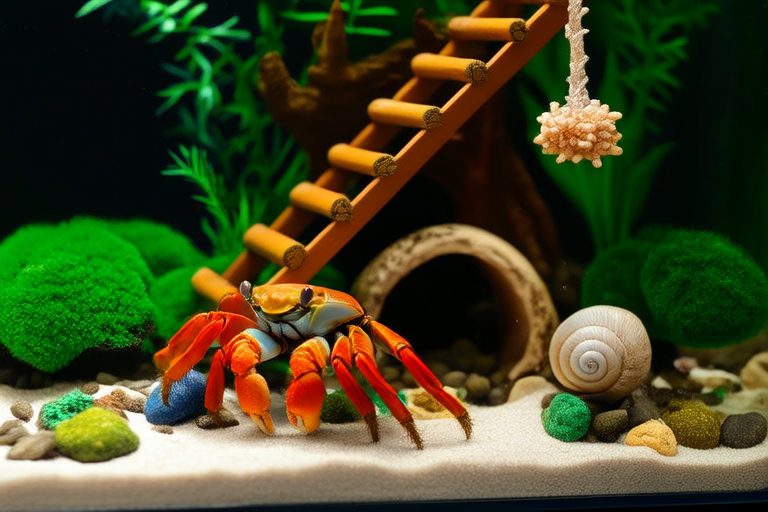DIY Hermit Crab Playground: A Creative Guide
Welcome to your ultimate guide on creating an engaging and stimulating environment for your hermit crabs! This comprehensive DIY guide will walk you through every step of building a hermit crab playground that’s both fun and safe. We’ll cover all the necessary materials, step-by-step setup instructions, safety tips, and ideas for environmental enrichment. Let’s dive into the world of hermit crab care and creativity!
Necessary Materials
- Playground Base: Choose a large, shallow container or aquarium with a secure lid. Ensure it has a smooth surface to prevent injuries.
- Substrate: Opt for a non-toxic substrate like sand, coconut fiber, or crushed coral. The substrate should be deep enough for your crabs to dig and burrow comfortably.
- Plants and Decorations: Add live or artificial plants, driftwood, rocks, and shells to create hiding spots and climbing structures. Ensure all items are clean and free from harmful chemicals.
- Food and Water Dishes: Provide small, shallow dishes for food and fresh water. Make sure they’re easy for your crabs to access and clean.
- Toys and Accessories: Introduce toys such as tunnels, bridges, and small ramps to encourage exploration and play. Look for items made from natural materials or specifically designed for hermit crabs.
- Temperature and Humidity Control: Maintain optimal temperature (75-85°F) and humidity (70-80%) levels using a heat lamp and a humidifier. Use a thermometer and hygrometer to monitor conditions.
- Cleaning Supplies: Prepare cleaning supplies like a siphon, aquarium-safe cleaner, and water conditioner to keep the playground clean and healthy.
Step-by-Step Setup Instructions
- Prepare the Container: Clean the container thoroughly with warm water and a mild detergent. Rinse well and dry completely before setting up the playground.
- Add Substrate: Pour a layer of substrate into the container, ensuring it’s deep enough for your crabs to burrow comfortably. Level the surface and gently tamp down any loose areas.
- Place Plants and Decorations: Arrange plants, driftwood, rocks, and shells throughout the playground to create hiding spots and climbing structures. Ensure items are securely placed and won’t topple over easily.
- Set Up Food and Water Dishes: Position the food and water dishes in easily accessible locations. Fill the water dish with dechlorinated water and place a small amount of food in the food dish.
- Introduce Toys and Accessories: Add tunnels, bridges, and ramps to encourage exploration and play. Ensure all items are stable and safe for your crabs to interact with.
- Install Temperature and Humidity Control: Set up the heat lamp and humidifier according to manufacturer instructions. Monitor temperature and humidity levels regularly to ensure optimal conditions.
- Final Checks: Inspect the playground for any potential hazards or gaps in the lid. Make sure everything is secure and ready for your crabs to explore.
Safety Tips
- Non-Toxic Materials: Always choose non-toxic materials for your hermit crab playground. Avoid items treated with pesticides, fertilizers, or other chemicals.
- Adequate Ventilation: Ensure proper ventilation by leaving a small gap in the lid or installing a mesh screen. This allows for air circulation while preventing escapes.
- Safe Substrate: Use a substrate that’s safe for your crabs to dig and burrow in. Avoid sharp or abrasive materials that could injure their delicate bodies.
- Regular Monitoring: Check the playground daily for any signs of wear or damage. Replace or repair items as needed to maintain a safe environment.
- Proper Hygiene: Clean the playground regularly using appropriate cleaning supplies. Remove uneaten food, soiled substrate, and waste to prevent contamination.
Environmental Enrichment Ideas
Fun Activities for Hermit Crabs
- Obstacle Course: Create an obstacle course using tunnels, bridges, and ramps. Encourage your crabs to navigate through the course, exploring new areas and interacting with different textures.
- Hiding Spot Hunt: Hide treats and snacks within the playground, encouraging your crabs to search for them. This activity stimulates their natural foraging behavior and provides mental stimulation.
- Water Play: Introduce a shallow water feature, such as a small pool or waterfall. Ensure the water is clean and dechlorinated. Watch as your crabs enjoy swimming and playing in the water.
- Shell Swap: Offer a variety of shells for your crabs to explore and potentially swap. This activity encourages social interaction and helps maintain a healthy shell collection.
Customization Options for Various Crab Habitats
- Desert Theme: For desert-loving hermit crabs, create a playground with a sandy substrate, cacti, and rock formations. Add a small heat lamp to simulate a warm, arid environment.
- Tropical Theme: Mimic a tropical rainforest by using a moist coconut fiber substrate, lush greenery, and a gentle waterfall. Ensure high humidity levels and provide plenty of hiding spots.
- Marine Theme: Re-create a marine environment with a saltwater pool, coral reefs, and seashells. Maintain proper salinity levels and provide ample space for swimming and exploration.
Conclusion
Building a hermit crab playground is a rewarding project that promotes the health and happiness of your beloved pets. By following this DIY guide, you can create a safe, stimulating environment that encourages exploration, play, and social interaction. Remember to prioritize safety, hygiene, and environmental enrichment when designing your hermit crab playground. With a little creativity and effort, you can build a custom playground that perfectly suits your hermit crabs’ unique needs and preferences.
